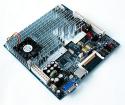New VIA mini-ITX board targets vertically challenged apps
Jun 24, 2004 — by LinuxDevices Staff — from the LinuxDevices Archive — 3 views [updated Jun. 26, 2004] — VIA is shipping an ultra-low profile mini-ITX mainboard suitable for Linux-based flat TVs, LCD-panel computers, and other vertically challenged devices. The Epia MS uses a minimalistic I/O backplate and SODIMM memory for a slimmer form-factor, and is VIA's first mini-ITX board… available with a fanless 1GHz Eden embedded processor.
[updated Jun. 26, 2004] — VIA is shipping an ultra-low profile mini-ITX mainboard suitable for Linux-based flat TVs, LCD-panel computers, and other vertically challenged devices. The Epia MS uses a minimalistic I/O backplate and SODIMM memory for a slimmer form-factor, and is VIA's first mini-ITX board… available with a fanless 1GHz Eden embedded processor.
(Click for larger view of VIA Epia MS)
VIA says the Epia MS delivers enhanced digital media performance with very low power consumption and quiet operation, making it ideal for living room applications such as flat-panel TVs.
Most VIA mini-ITX boards include a tall backpanel with a broad array of I/O devices. The new Epia MS instead includes a low-profile backpanel with only a CRT, Ethernet, and Cardbus CompactFlash connectors. Other I/O devices, including 6-channel audio, TV-out, and six USB 2.0 ports, are available as pin headers on the board itself.
In order to further reduce board height, the Epia MS uses a low profile SODIMM memory slot on the underside of the board, instead of the perpendicular SDRAM slot used on other VIA mini-ITX boards. The SODIMM slot supports laptop-style DDR266 SDRAM SODIMMs.


The Epia MS's backpanel, top and bottom views
(Click either image to enlarge)
The Epia MS is the first VIA mainboard available with the fanless 1GHz VIA Eden ESP processor announced last February. The board is also available with a fanless 800MHz VIA Eden ESP processor, or with a “fansink” equipped 1.2GHz VIA C3.
The Eden and C3 are based on the die, but the chips are tested and treated differently so that the Eden reliably supports the higher temperatures resulting from fanless operation. Both chips include the Padlock ACE security features announced last October and now supported by Linux and BSD kernels and a growing number of applications. The Padlock ACE engine can encrypt or decrypt data at a sustained rate of 12.8Gb/s, according to VIA, and supports AES keys of 128-bits, 196-bits, and 256-bits. More information on the VIA PadLock ACE is available in LinuxDevices.com's interview with VIA processor chief Glenn Henry, and at VIA's website.
In addition to a VIA C3 or Eden processor, the Epia MS includes VIA's CLE266 chipset with integrated S3 Unichrome 2D/3D graphics. The CLE266 includes hardware MPEG acceleration supported by a binary-only shared object library from VIA, but an open source effort to reverse-engineer the MPEG engine and thus provide more complete support under Linux is underway.
The board also includes the VIA VT1622A TV-encoder chip, and the VIA Vinyl Six-TRAC 6-channel surround sound chip.


The Epia MS, top and bottom.
(Click either image to enlarge)
Additional interfaces include a dual-channel ATA/133 IDE, up to six USB 2.0 connections, S-Video and RCA TV-Out (NTSC & PAL), and 10/100 Mbps Fast Ethernet. The VIA EPIA MS also offers support for a growing number of LVDS embedded LCD panels, and has a PCI slot for expandability options, according to VIA.
The 6.7 x 6.7-inch mini-ITX form-factor board is compatible with a wide variety of mini-ITX, flexATX, and microATX enclosures.
“The VIA EPIA MS is poised to meet the needs of the fast-evolving market for personal electronics. Its intuitive design targets devices where aesthetics and ease of use can be achieved without compromising on full digital media functionality,” said Steven S. Lee, head of VIA's Embedded Platform Division.
This article was originally published on LinuxDevices.com and has been donated to the open source community by QuinStreet Inc. Please visit LinuxToday.com for up-to-date news and articles about Linux and open source.